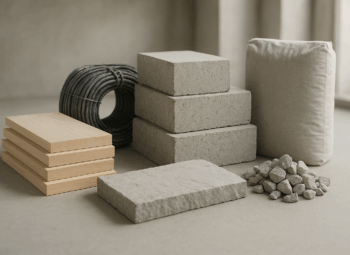Modern construction teams and global procurement managers operate under intense time pressure, tight budgets, and frequent supply-chain disruptions. These conditions increase stress and contribute to mental health challenges across project stakeholders. Firms that adopt resilient sourcing strategies and predictable material flows reduce uncertainty, lower stress, and improve team wellbeing. This article links material choices and global sourcing practices to practical outcomes for operational stability and mental health.
Research Output: -1760679644
Top Imported Materials Used in Modern Construction: Overview
Developers and contractors import a concentrated set of materials that form the backbone of modern construction. Choosing the right supplier, logistics path, and compliance approach directly affects project timelines, cost predictability, and worker safety.
Key imported material categories
- Structural steel and reinforcing bars
- Portland cement clinker and blended cements
- Engineered timber and specialty lumber
- Architectural and tempered glass
- Insulation materials (EPS, XPS, mineral wool)
- Gypsum board and drywall systems
- PVC and HDPE pipes and fittings
- Aluminium extrusions and façade panels
Why these materials matter
These materials combine high volume with significant impact on structural performance, energy efficiency, and lifecycle emissions. Import decisions for these items determine lead times, customs complexity, and the project’s environmental footprint.
Section 1: Structural Materials — Performance, Sourcing, and Risk
Structural materials dominate both cost and risk. Steel and cement supply volatility directly delays schedules and raises stress for procurement teams.
Structural steel and rebar
Steel offers predictable strength and rapid on-site assembly. However, global pricing and shipping cycles cause sudden cost shifts.
- Key features: high strength-to-weight ratio, prefabrication-friendly, recyclable
- Sourcing advice: lock long-lead contracts with supplier verification and buffer stock
- Compliance: request mill test certificates and verify chemical composition
Cement and clinker
Many regions rely on imported clinker or blended cement. Transport cost and import duties increase project costs.
- Key features: foundational for concrete, affects curing and durability
- Sourcing advice: prefer local blended options where available to reduce carbon and lead time
- Quality checks: perform fineness, setting time, and compressive strength tests
Section 2: Envelope and Interiors — Energy Efficiency and Supply Choices
Building envelope materials influence code compliance, occupant comfort, and operational costs. Sourcing them strategically improves long-term performance and reduces maintenance stress.
Glazing and aluminium systems
Imported glass and aluminium systems offer design flexibility but require tight coordination for thermal performance.
- Key features: thermal break options, low-e coatings, bespoke shapes
- Procurement tip: align glass lead times with façade installation windows
- Risk control: inspect for thermal performance certificates and impact ratings
Insulation and gypsum
Insulation and gypsum board drive energy codes and finish quality. Choose materials with clear product data sheets and sustainability credentials.
- Key features: R-value, fire rating, moisture performance
- Sourcing tip: favor certified mineral wool or cellulose where fire-safety and indoor air quality matter
- On-site handling: protect materials from moisture to avoid rework and schedule stress
Section 3: Carbon-Neutral Supply Chains — Practical Steps and Materials Impact
Reducing embodied carbon in construction aligns with investor mandates and lowers regulatory risk. Procurement teams can make immediate gains by choosing low-carbon imports and optimizing logistics.
Practical actions to reduce carbon
- Specify low-carbon cement alternatives such as blended cement or geopolymer mixes
- Source recycled-content steel and request supplier emissions disclosures
- Consolidate shipments to reduce freight emissions and administrative load
- Assess local substitutes that reduce sea freight and customs complexity
Example: Low-carbon façade strategy
A mid-size developer replaced imported aluminium panels with locally extruded panels made from 60% recycled aluminium. The project reduced lead time by six weeks and cut embodied carbon by an estimated 20% per façade element. Procurement saved cost and reduced contractor stress from delayed deliveries.
Section 4: Factory Verification, Compliance and Quality Assurance
Factory verification prevents quality failures and regulatory non-compliance. Teams that perform targeted audits maintain steady workflows and reduce costly rework.
Verification checklist
- Confirm business registration and export licenses
- Request production process documentation and capacity reports
- Verify certifications: ISO 9001, ISO 14001, CE marking, ASTM/EN test reports
- Perform random sample testing and witnessed factory acceptance tests (FAT)
- Assess labor practices and safety management to reduce reputational risk
Practical verification example
A construction firm importing pre-cast panels commissioned an independent factory audit. The audit revealed inconsistent curing cycles. The firm adjusted acceptance criteria and required equipment upgrades. The change eliminated a recurring crack pattern and shortened remedial work from four weeks to one.
Section 5: Production Optimization, Logistics and Actionable Sourcing Plan
Optimize production and logistics to control costs, reduce schedule risk, and protect team wellbeing. Use a simple sourcing plan to align procurement with construction milestones.
Actionable sourcing plan (practical example)
Scenario: mid-size urban residential development requiring steel frames, glazing, and gypsum. Timeline: 18 months.
- Phase 1 — Early procurement: secure steel billets and long-lead glazing within first 3 months
- Phase 2 — Factory verification: audit top two steel suppliers and one glazing manufacturer by month 4
- Phase 3 — Logistics optimization: consolidate glazing and aluminum into one FCL shipment to reduce handling
- Phase 4 — Quality assurance: implement FAT for glazing units and pre-pour tests for concrete elements
- Phase 5 — Contingency: maintain 8–12 week buffer stock for high-risk items like cement and rebar
KPIs and monitoring
- On-time delivery rate for imported materials
- Rejected shipment percentage after inspection
- Embodied carbon estimate per major material
- Lead time variance against baseline
Tracking these KPIs helps teams spot trends early, reduce last-minute procurement stress, and protect workforce mental health by creating predictable workflows.
Practical negotiation and cost control tactics
Negotiate payment terms and volume discounts to smooth cash flow. Use staged payments linked to production milestones to align incentives. Negotiate freight terms (FOB vs CIF) that match your logistics capacity.
- Use short, clear contracts that allocate quality and delay risk
- Lock prices with hedges for commodity-exposed materials where appropriate
- Bundle purchases across projects to improve bargaining power
These tactics reduce supplier disputes and avoid emergency spend that raises pressure on procurement teams.
Conclusion and Next Steps
Imported construction materials define project performance, budget certainty, and environmental impact. Procurement teams that combine rigorous factory verification, carbon-aware sourcing, and logistics optimization achieve predictable schedules and reduce stress across organizations.
Execute the practical sourcing plan above, monitor KPIs, and prioritize supplier transparency. These actions improve commercial outcomes and support better mental health among project teams by lowering uncertainty.
To discuss a tailored sourcing strategy for your project and reduce procurement risk, visit our contact page:





